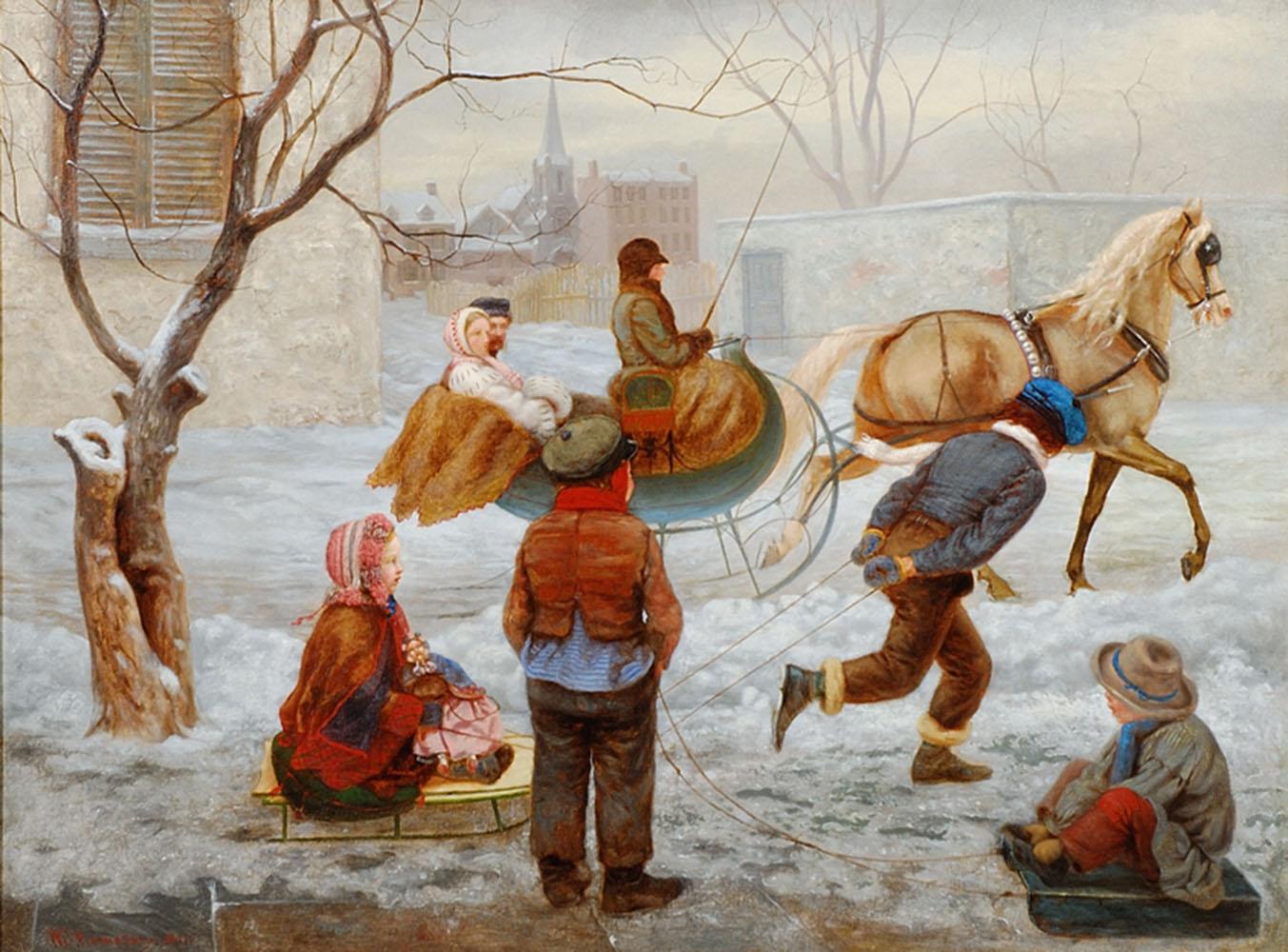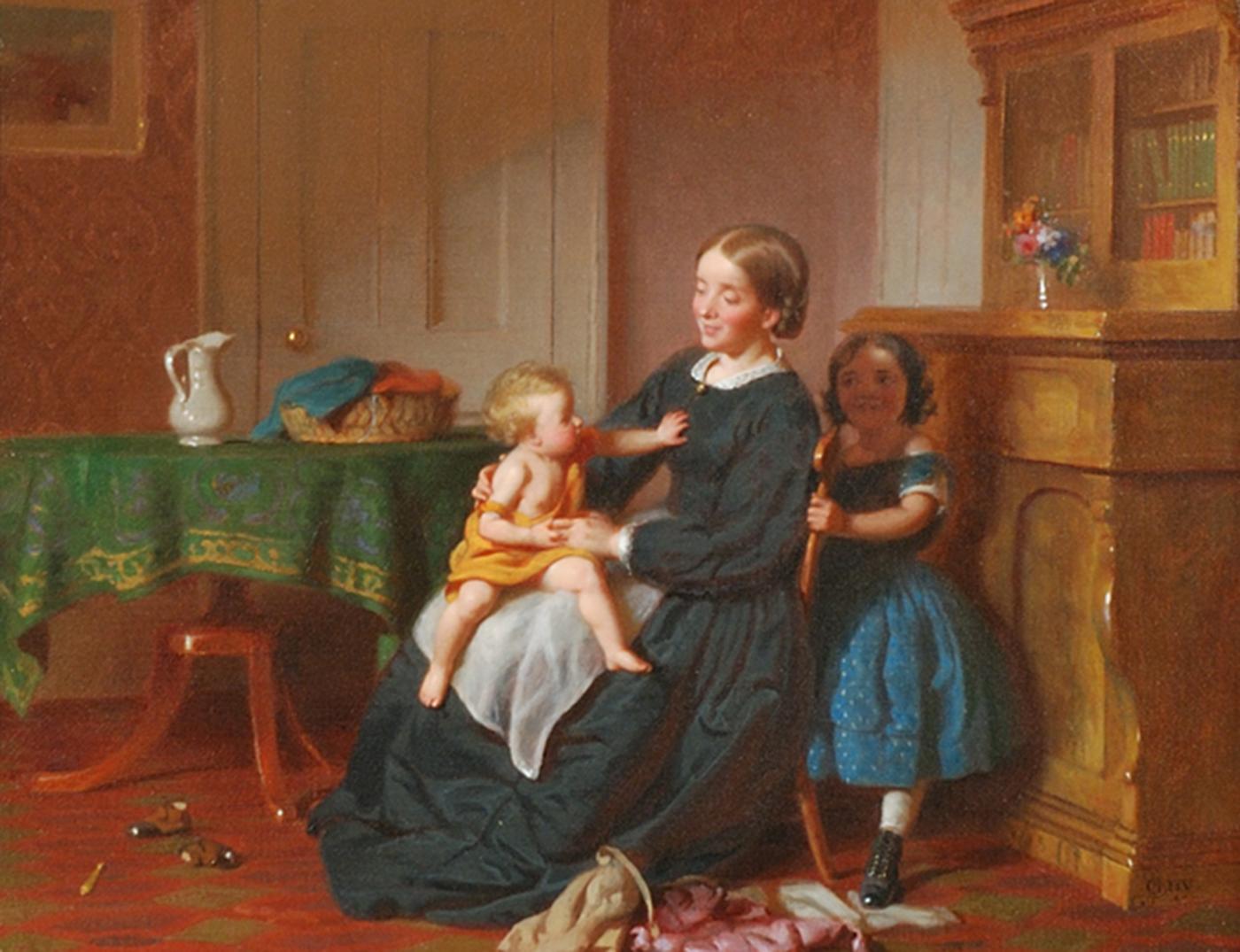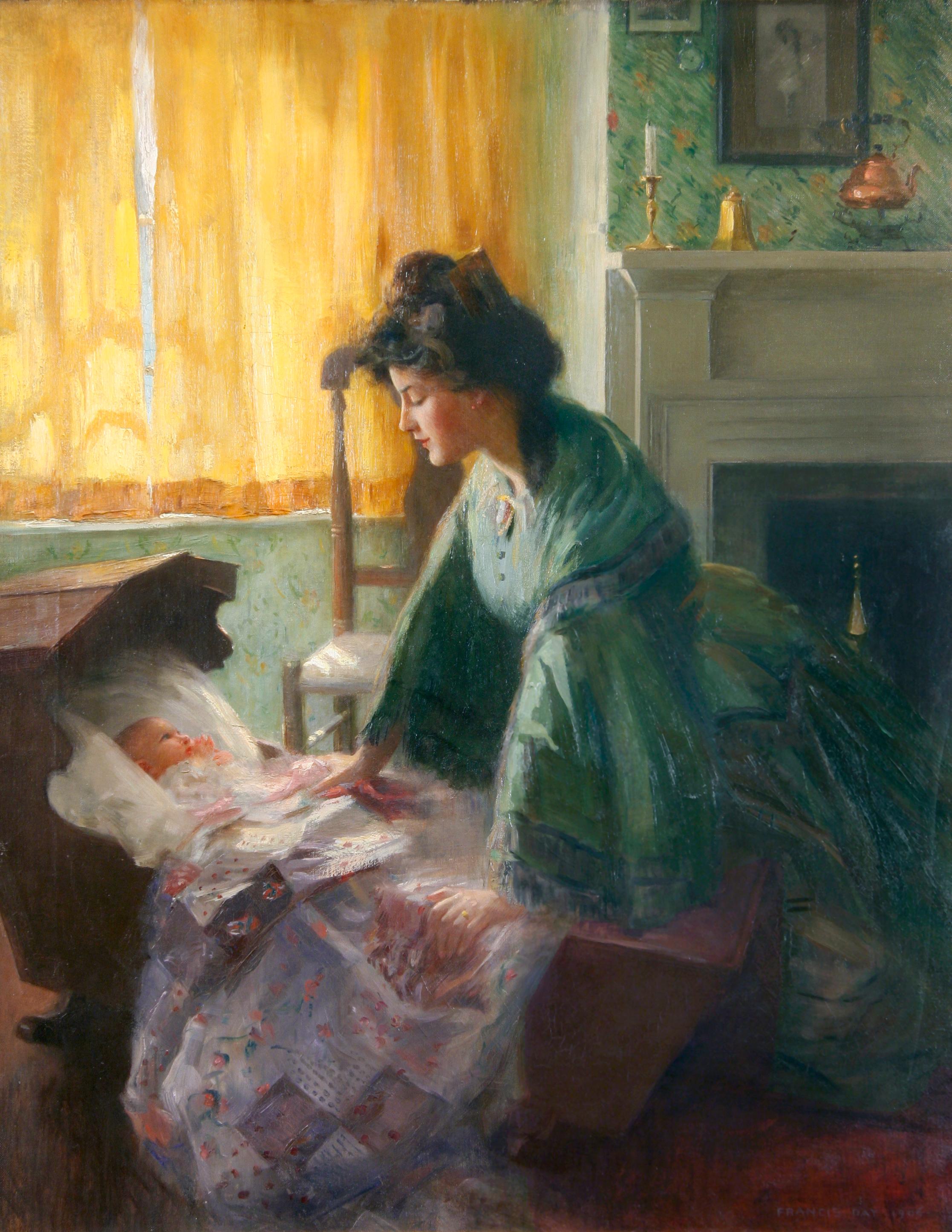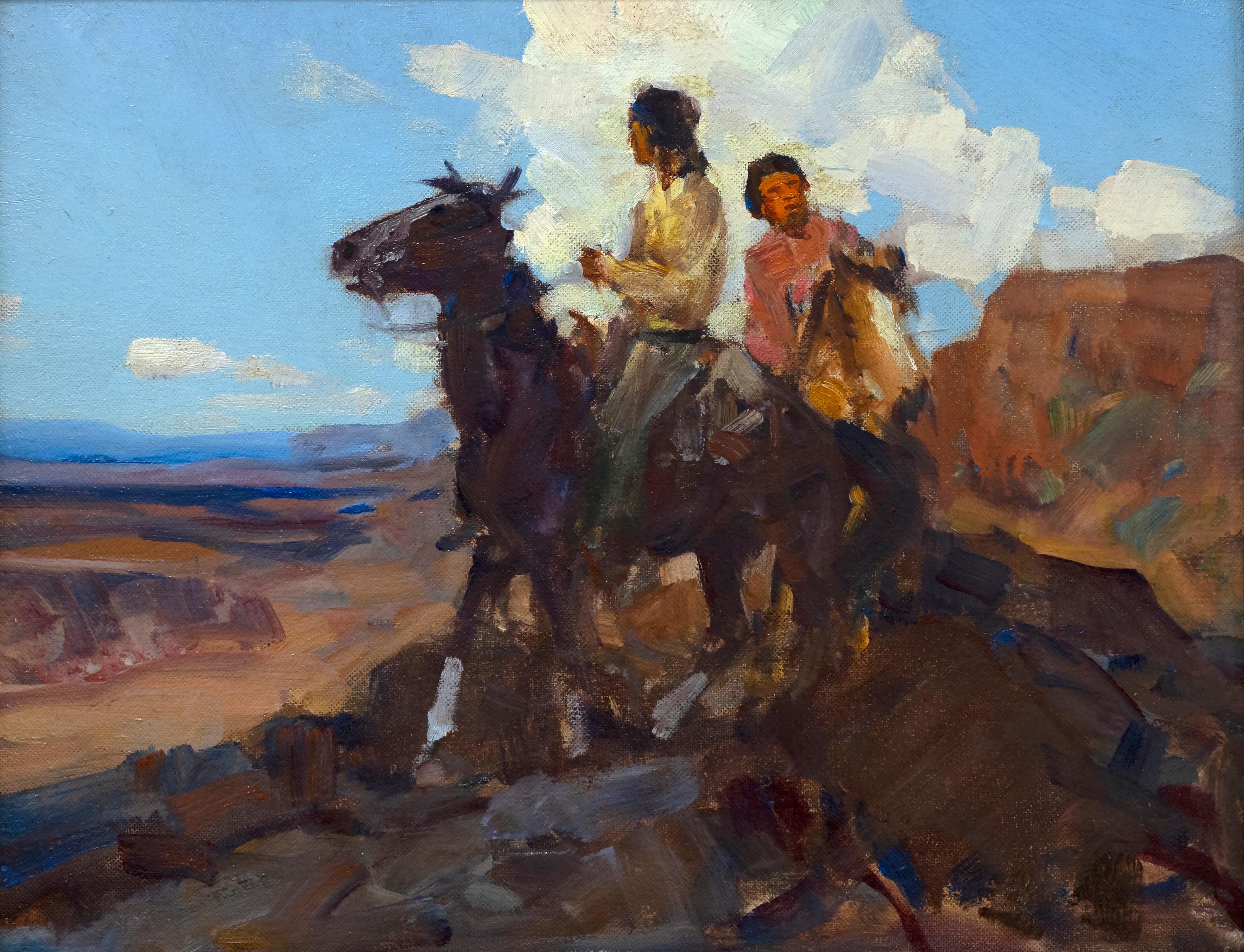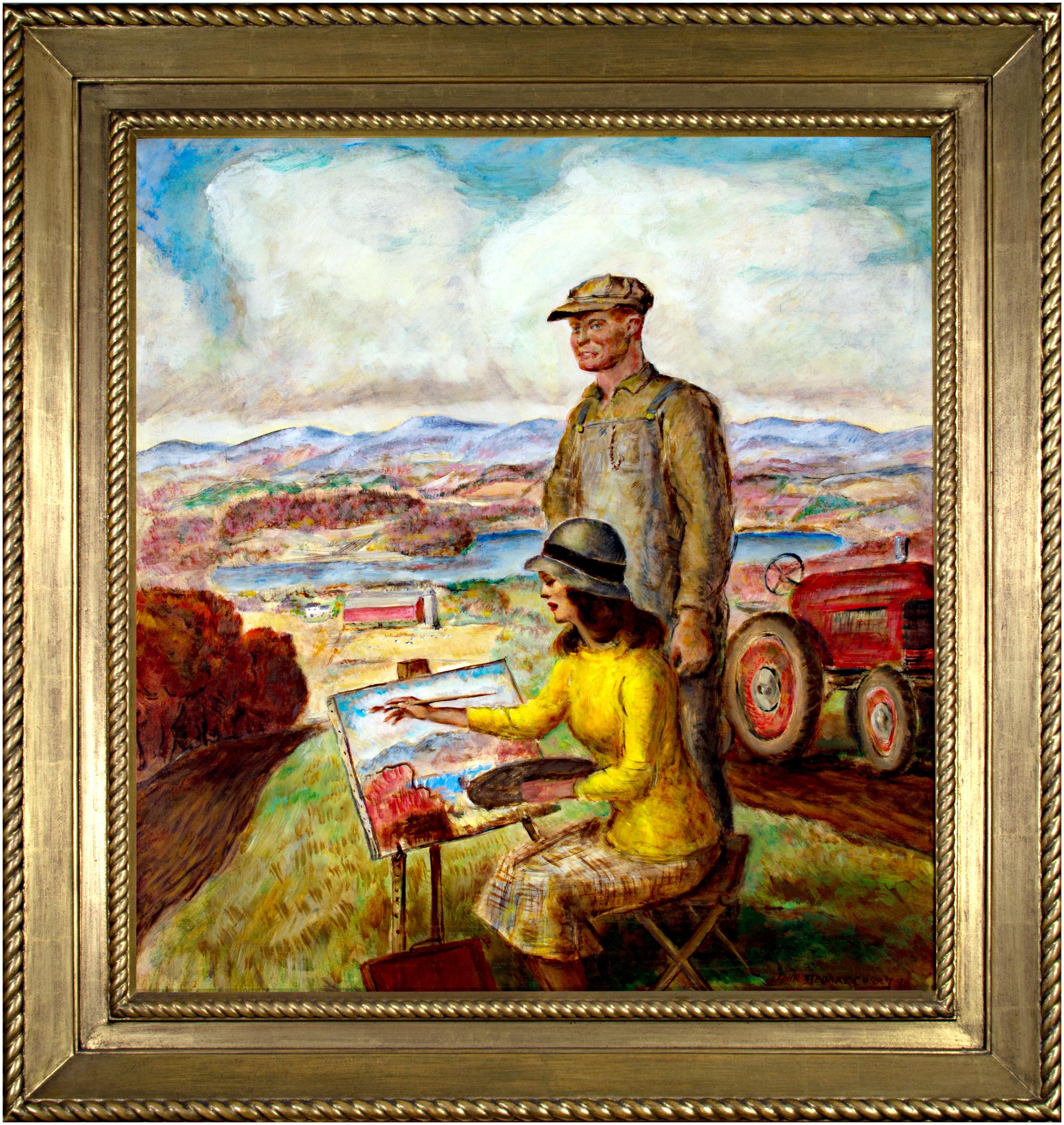Items Similar to Allegory of Defense Industry (figurative male illustration)
Want more images or videos?
Request additional images or videos from the seller
1 of 15
Frank GodwinAllegory of Defense Industry (figurative male illustration)1919
1919
About the Item
Frank Godwin (1889-1959). Allegory of Defense Industry, 1919. Oil on canvas. Signed lower right. Image measures 20.75 x 26.25 inches. The canvas measures 24 x 36 inches in total. Annotated on top reverse stretcher: Page 1, 13th Issue, August 31, 1919. The publication for which this project was commissioned is still unknown. Godwin's image depicts a young and healthy everyman painted in a naturalistic style. The figure is heroic but unidealized. Unequivocally, he can be identified as an allegorical figure of Industry: in this case, war or defense. A premier example from the Golden Age of illustration, demonstrating distinct influences of the Brandywine School.
The piece is further annotated on reverse canvas: Aug 31. Annotated in white margin areas recto. Upper left: 5472-J, upper right: wanted August 9th, Lower left (indistinct), lower center: 9 3/8. These are all notes to editor and printer.
Condition:
The piece has been professionally conserved under our express guidance. Conservator's report available. The painting has been cleaned and strip lined, restretched upon original stretcher. There are no repaired punctures or tears. Minor paint flaking at upper left ( just below aqua blue sky area) has been stabilized and inpainted.
Surface is entirely flat and stable with no flaking.
There are no other areas of paint loss other than what is evident in white margins. The decision to leave this area intact was made for purposes of authenticity, in the event the piece is acquired by a museum, archive or purist. Of course, a conservator could take the piece to 100% with subsequent inpainting. Alternately, the canvas could be cut down and restretched by a conservator to present the color image only. At present, the choice is yours and at your discretion.
Biography:
Frank Godwin was a prominent painter, magazine illustrator, and advertising artist, who lent his sophisticated talents to the comics for the last 30 years of his life. He contributed to numerous strips in the daily papers. His own creations, "Connie" (1927-1944) and "Rusty Riley" (1948-1959), are among the most highly admired continuity strips in the literature of the comics.
Godwin was the son of an editor for the Washington (D.C.) Star, and began his career in art with his fathers paper at the age of 16. A desire both to perfect his work and broaden his range of opportunity drew him to New York City. There, he studied at the Art Students League. From his late teens he supported himself as a free-lance cartoonist and illustrator. The close companionship and support of the older James Montgomery Flagg, already an established commercial artist, helped him to enter the market. He was soon selling to a large variety of periodicals. His advertising art appeared in virtually all the popular magazines of the time, and he was much sought after to illustrate fiction for such magazines as Colliers, Liberty, and Cosmopolitan.
His illustrations for Winstons popular editions of the classics, in the romantic style of Flagg and Charles Dana Gibson, placed him among the most successful book illustrators of the Twenties and Thirties. He also painted in oils, and his murals for the Kings County Hospital in Brooklyn, New York, and the Riverside Yacht Club in Greenwich, Connecticut, are still much admired. He was an active member of the Society of Illustrators for many years, serving for a time as its vice president. He has been elected to its Hall of Fame.
In the early 1920s, Godwin became a staff artist with the Philadelphia Public Ledger, doing covers for the papers Sunday magazine section and illustrating its fiction. His Vignettes of Life, a series of humorous domestic scenes, began in the Ledger in 1924 and was so successful that he was soon in demand for other assignments with the Ledger. He drew Roy Powers, Eagle Scout anonymously for a long time. In 1927, he began his first signed continuity strip, Connie, which debuted on November 13th as a Sunday strip and added dailies on May 13, 1929.
Connie was an exciting, fast-paced adventure strip, liberally laced with humor. It was about one of the new, liberated women, Connie Kurridege, a dauntless lass. In the strips first year, she bested half a dozen villains: an aviatrix, an interior decorator, a secretary, a travel agent, a private detective, and an ace reporter. The resourceful young lady later served a stint as an astronaut in a prolonged science fiction episode. Connie was never carried in many newspapers, however, and folded in 1944.
In 1948, Godwin launched Rusty Riley for King Features, with the dailies written by Rod Reed. It debuted on January 26. The Sundays, written by Godwins brother, Harold, debuted on June 27th. This nostalgic evocation of innocent boyhood, called up a period decades earlier despite the contemporary clothes and automobiles, romanticized its subject in a way already passé; it survived largely because of its handsome art until a few weeks before Godwins death on August 5, 1959.
Godwins elegance of design and meticulous precision of style brought his work to pictorial heights seldom matched in the comics. Never compromising the aesthetic ideals of the illustrator and painter, he employed the same richly textured compositions and painstaking cross-hatching in his comics that he used in book illustrations, giving his work a graphic sophistication that virtually disappeared from the comics with his death.
- Creator:Frank Godwin (1889 - 1959, American)
- Creation Year:1919
- Dimensions:Height: 26.25 in (66.68 cm)Width: 20.75 in (52.71 cm)
- Medium:
- Movement & Style:
- Period:
- Condition:
- Gallery Location:Wilton Manors, FL
- Reference Number:1stDibs: LU24526403112
About the Seller
4.9
Gold Seller
These expertly vetted sellers are highly rated and consistently exceed customer expectations.
Established in 2007
1stDibs seller since 2015
328 sales on 1stDibs
Typical response time: 9 hours
- ShippingRetrieving quote...Ships From: Wilton Manors, FL
- Return PolicyA return for this item may be initiated within 7 days of delivery.
More From This SellerView All
- Fishermen, Bahamas (North Carolina artist)By Frank Stanley HerringLocated in Wilton Manors, FLBeautiful ca. 1935 painting by American artist, Frank Stanley Herring (1894-1966). Watercolor on heavy rag handmade paper measures 14.5 x 19 inches, 23 x 28 inches in original vintag...Category
1930s American Realist Figurative Paintings
MaterialsHandmade Paper, Watercolor
- Russian Cubist Portrait of a WomanLocated in Wilton Manors, FLBeautiful cubist portrait of a woman by unknown Russian artist. Oil on canvas measures 17 x 25 inches. Signed and dated lower right. Label fragments affixed on verso.Category
1980s Cubist Abstract Paintings
MaterialsCanvas, Oil
- Young Female Ballet dancerLocated in Wilton Manors, FLBeautiful WPA era ca. 1930s portrait of a ballet dancer signed F. Miller. Oil on canvas measuring 18 x 24 inches; 24 x 30 inches in contemporary frame. Signed on back.Category
1930s Realist Figurative Paintings
MaterialsCanvas, Oil
- CherubsBy George Henry HallLocated in Wilton Manors, FLGeorge Henry Hall (1825-1913). Cupids, 1875. Oil on canvas, 6 x 9.25 inches; 10 x 13.25 inches framed. Original frame with label verso. Excellent condition with no damage or restoration. Signed and dated lower right. Price on request Biography: Birth place: Manchester, NH Addresses: Primarily in NYC from 1852 Profession: Still-life, genre, portrait painter Studied: between 1849-52 in Paris and Rome; and Düsseldorf Royal Acad. with Eastman Johnson Exhibited: PAFA, 1853-68; Royal Acad., British Inst., Suffolk Street Gal., all in London, 1858-74; Brooklyn AA, 1861-81; NAD, 1862-1900; AIC, 1888; Boston AC, 1881, 1889 Member: ANA, 1853; NA, 1868; Century Assn. Work: MMA; BM; BMFA Comments: Best known for his still-lifes, he specialized in detailed and vividly colored fruit and flower...Category
19th Century Realist Figurative Paintings
MaterialsOil, Canvas
- Fisherman at DuskBy Oskar D'AmicoLocated in Wilton Manors, FLOskar D'Amico (1923-2003). Fisherman at Dusk, c.1960. Oil on linen canvas, 16 x 30 inches; 18 x 32 inches (frame). Signed lower right. Excellent condition with no damage or conservation. Biography: Oskar Maria D'Amico (February 22, 1923 – May 3, 2003) was an active Italian artist in Rome, Naples, Lanciano, Cisterna, Milan, Gallarate, Torino, Zagabria, Paris, Toulouse, Melun, Carenac, Maubeuge, Madrid, Barcelona, Zaragoza, Budapest, Győr, Mexico City, Cuernavaca, Morelia, Toronto, New York City, Philadelphia, Los Angeles, San Francisco, Miami, Denver, Santa Fe, Albuquerque and Socorro, between 1943 and 2003. He is considered a Nomad artist because of his ability to work in various styles. He had three major periods in his artistic life: Figurative, Materic and Geometric. [1]He also was an outstanding art director for more than 75 epic movies. D'Amico had a very outgoing personality. He was a non-conformist, which was reflected in his work throughout his life. D'Amico was born in CastelFrentano, Italy, a small village in Abruzzo. At a young age, he felt he had to leave and dive into the big world. After being a seminarist with the Salesiani during World War II, he left Naples, where he studied architecture, and began a great adventure in Rome. He specialized at the time in decorating nightclubs and bars, and invented a special type of double ceiling to hide the lights. D'Amico, who was self-taught as a teenager in drawing and painting, burst onto the filmmaking scene in Rome when an art director asked him to do a perspective of a set design. Soon other moviemakers were calling him.[2] D'Amico was an art director on 75 films including two by Orson Welles. D’Amico was able to create a real marble floor in the set of the palace of the King Saul, in "David and Goliath" directed by Orson Welles. Art directors previously painted a simulated marble on top of concrete due to the cost of the real thing. D'Amico became an associate of Jadran Films in ex-Yugoslavia, which specialized in Roman and Egyptian constructions. While an art director, he never stopped painting. His faceless clowns, reflecting the people who had no identity after World War II, were a big success. In the early 1960s, D'Amico moved with his family to Toronto, Canada, another place he felt was too small. He left for Philadelphia and New York City, which affected his work. He turned his focus to abstract, and for more than a decade created abstract Expressionist paintings "on the plane of all matter" that he called "Materic". The Materic style, which he invented, was done in several media and could not be changed once on the canvas. The paintings were very well received. D’Amico sold more than 400 in Philadelphia and New York City. Unfortunately he had to stop doing the Materics because the colors he used were harmful to his liver. In the mid 1970s, he returned to his architectural roots and developed a new vision for Abstract Constructivism using just acrylic colors. Presented in Paris by his French Art dealer, Francoise Tournier, at the Grand Palais de Paris, and in Mexico City, D'Amico's interpretation of the "New Geometry" was widely admired. In 1983, when he presented the work at the Bodley Gallery, people whispered that he had the potential to be the new Picasso because of his eclecticism and the Nomad nature of his styles. In 1987, D'Amico abandoned the gypsy life and settled in New Mexico. Albuquerque was the perfect place to dedicate himself 100 percent to his work.[3] There were no distractions and a good climate that reminded him of his beloved Cuernavaca in Mexico. Staying in close contact with his French art dealer Tournier, D’Amico had several shows in Denver at the Helen Karsh Gallery and in Albuquerque at the Black Swan and Café Galleries. At least once a year, D’Amico went to Europe to immerse himself in the antique world and visit museums and galleries. In 1992, visiting Tournier at the Castle of Saint Cirq Lapopie, he met the man who founded the MADI movement in 1940, Carmelo Arden Quin...Category
1960s Abstract Figurative Paintings
MaterialsCanvas, Oil
- Tattoo Parlor Sailor (WPA era woman artist)By Helen MaltaLocated in Wilton Manors, FLHelen Malta (b.1912). Tattoo Parlor, ca. 1935. Oil on canvas, 20 x 33 inches. Signed lower right. Metropolitan Museum of Art reproduction rights stamp on r...Category
1930s Abstract Abstract Paintings
MaterialsCanvas, Oil
You May Also Like
- The RaceBy William John HennessyLocated in New York, NYWilliam John Hennessy was born in Ireland. He came to America in 1849 with his mother and brother a year after his father had fled their homeland after taking part in the unsuccessful Young Ireland Party uprising. The Hennessys settled in New York, and when young William came of age, he decided upon a career as an artist. At the age of fifteen, he enrolled at the National Academy of Design, where he learned to draw from the antique, and the following year he was granted admission to the Academy’s life-drawing class. Hennessy first exhibited at the National Academy in 1857, starting a continuous run of appearances in their annuals that lasted until 1870, when he expatriated himself to Europe. During his time in America, Hennessy was principally known as a genre painter and prolific illustrator for such publications as Harper’s Weekly and a number of books, including illustrated works of William Cullen Bryant...Category
19th Century American Realist Figurative Paintings
MaterialsCanvas, Oil
- Peek-a-BooBy Seymour Joseph GuyLocated in New York, NYIn the latter half of the nineteenth century and into the first decade of the twentieth, New York City art aficionados could count on finding recent work of Seymour Joseph Guy hanging on the walls of the city’s major galleries. Primarily a genre artist, but also a portraitist, between 1859 and 1908 Guy showed more than seventy works at the National Academy of Design. From 1871 to 1903 he contributed over seventy times to exhibitions at the Century Club. From 1864 to 1887, he sent about forty pictures to the Brooklyn Art Association. A good number of these works were already privately owned; they served as advertisements for other pictures that were available for sale. Some pictures were shown multiple times in the same or different venues. Guy was as easy to find as his canvases were omnipresent. Though he lived at first in Brooklyn with his family and then in New Jersey, from 1863 to his death in 1910 he maintained a studio at the Artist’s Studio Building at 55 West 10th Street, a location that was, for much of that period, the center of the New York City art world. Guy’s path to a successful career as an artist was by no means smooth or even likely. Born in Greenwich, England, he was orphaned at the age of nine. His early interest in art was discouraged by his legal guardian, who wanted a more settled trade for the young man. Only after the guardian also died was Guy free to pursue his intention of becoming an artist. The details of Guy’s early training in art are unclear. His first teacher is believed to have been Thomas Buttersworth...Category
19th Century American Realist Figurative Paintings
MaterialsCanvas, Oil
- Light of LoveLocated in Washington, DCExhibited: National Academy of Design, New York, 1906 (as no. 101) Art Institute of Chicago, 1908 (as no. 74)Category
Early 1900s American Realist Figurative Paintings
MaterialsCanvas, Oil
- ScoutingBy Frank Tenney JohnsonLocated in Palm Desert, CA"Scouting" is an oil on canvas painting by Frank Tenney Johnson. The framed piece measures 23 3/4 x 27 3/4 x 3 1/4 inches. Johnson was well-known for his work of the American west, particularly for his portrayal of cowboys at night, lit by moonlight. Johnson utilized knives and fingers when painting, so his work is recognizable for its distinctive marks. Provenance: Biltmore Galleries, Scottsdale...Category
Early 20th Century American Realist Landscape Paintings
MaterialsCanvas, Oil
- 'Sketching Wisconsin' original oil painting, SignedBy John Steuart CurryLocated in Milwaukee, WIJohn Steuart Curry "Sketching Wisconsin," 1946 oil on canvas 31.13 x 28 inches, canvas 39.75 x 36.75 x 2.5 inches, frame Signed and dated lower right Overall excellent condition Presented in a 24-karat gold leaf hand-carved wood frame John Steuart Curry (1897-1946) was an American regionalist painter active during the Great Depression and into World War II. He was born in Kansas on his family’s farm but went on to study art in Chicago, Paris and New York as young man. In Paris, he was exposed to the work of masters such as Peter Paul Rubens, Eugène Delacroix and Jacques-Louis David. As he matured, his work showed the influence of these masters, especially in his compositional decisions. Like the two other Midwestern regionalist artists that are most often grouped with him, Grant Wood (American, 1891-1942) and Thomas Hart Benton (American, 1889-1975), Curry was interested in representational works containing distinctly American subject matter. This was contrary to the popular art at the time, which was moving closer and closer to abstraction and individual expression. Sketching Wisconsin is an oil painting completed in 1946, the last year of John Steuart Curry’s life, during which time he was the artist-in-residence at the University of Wisconsin in Madison. The painting is significant in Curry’s body of work both as a very revealing self-portrait, and as a landscape that clearly and sensitively depicts the scenery of southern Wisconsin near Madison. It is also a portrait of the artist’s second wife, Kathleen Gould Curry, and is unique in that it contains a ‘picture within a picture,’ a compositional element that many early painting masters used to draw the eye of the viewer. This particular artwork adds a new twist to this theme: Curry’s wife is creating essentially the same painting the viewer is looking at when viewing Sketching Wisconsin. The triangular composition of the figures in the foreground immediately brings focus to a younger Curry, whose head penetrates the horizon line and whose gaze looks out towards the viewer. The eye then moves down to Mrs. Curry, who, seated on a folding stool and with her hand raised to paint the canvas on the easel before her, anchors the triangular composition. The shape is repeated in the legs of the stool and the easel. Behind the two figures, stripes of furrowed fields fall away gently down the hillside to a farmstead and small lake below. Beyond the lake, patches of field and forest rise and fall into the distance, and eventually give way to blue hills. Here, Curry has subverted the traditional artist’s self-portrait by portraying himself as a farmer first and an artist second. He rejects what he sees as an elitist art world of the East Coast and Europe. In this self-portrait he depicts himself without any pretense or the instruments of his profession and with a red tractor standing in the field behind him as if he was taking a break from the field work. Here, Curry’s wife symbolizes John Steuart Curry’s identity as an artist. Compared with a self-portrait of the artist completed a decade earlier, this work shows a marked departure from how the artist previously presented and viewed himself. In the earlier portrait, Curry depicted himself in the studio with brushes in hand, and with some of his more recognizable and successful canvases behind him. But in Sketching Wisconsin, Curry has taken himself out of the studio and into the field, indicating a shift in the artist’s self-conception. Sketching Wisconsin’s rural subject also expresses Curry’s populist ideals, that art could be relevant to anyone. This followed the broad educational objectives of UW’s artist-in-residence program. Curry was appointed to his position at the University of Wisconsin in 1937 and was the first person to hold any such position in the country, the purpose of which was to serve as an educational resource to the people of the state. He embraced his role at the University with zeal and not only opened the doors of his campus studio in the School of Agriculture to the community, but also spent a great deal of time traveling around the state of Wisconsin to visit rural artists who could benefit from his expertise. It was during his ten years in the program that Curry was able to put into practice his belief that art should be meaningful to the rural populace. However, during this time he also struggled with public criticism, as the dominant forces of the art market were moving away from representation. Perhaps it was Curry’s desire for public acceptance during the latter part of his career that caused him to portray himself as an Everyman in Sketching Wisconsin. Beyond its importance as a portrait of the artist, Sketching Wisconsin is also a detailed and sensitive landscape that shows us Curry’s deep personal connection to his environment. The landscape here can be compared to Wisconsin Landscape of 1938-39 (the Metropolitan Museum of Art), which presents a similar tableau of rolling hills with a patchwork of fields. Like Wisconsin Landscape, this is an incredibly detailed and expressive depiction of a place close to the artist’s heart. This expressive landscape is certainly the result of many hours spent sketching people, animals, weather conditions and topography of Wisconsin as Curry traveled around the state. The backdrop of undulating hills and the sweeping horizon, and the emotions evoked by it, are emphatically recognizable as the ‘driftless’ area of south-central Wisconsin. But while the Metropolitan’s Wisconsin Landscape conveys a sense of uncertainty or foreboding with its dramatic spring cloudscape and alternating bands of light and dark, Sketching Wisconsin has a warm and reflective mood. The colors of the foliage indicate that it is late summer and Curry seems to look out at the viewer approvingly, as if satisfied with the fertile ground surrounding him. The landscape in Sketching Wisconsin is also revealing of what became one of Curry’s passions while artist-in-residence at UW’s School of Agriculture – soil conservation. When Curry was a child in Kansas, he saw his father almost lose his farm and its soil to the erosion of The Dust Bowl. Therefore, he was very enthusiastic about ideas from UW’s School of Agriculture on soil conservation methods being used on Wisconsin farms. In Sketching Wisconsin, we see evidence of crop rotation methods in the terraced stripes of fields leading down the hillside away from the Curry’s and in how they alternate between cultivated and fallow fields. Overall, Sketching Wisconsin has a warm, reflective, and comfortably pastoral atmosphere, and the perceived shift in Curry’s self-image that is evident in the portrait is a positive one. After his rise to favor in the art world in the 1930’s, and then rejection from it due to the strong beliefs presented in his art, Curry is satisfied and proud to be farmer in this self-portrait. Curry suffered from high blood...Category
1940s American Realist Figurative Paintings
MaterialsOil, Canvas
- Antique American Oil Painting Portrait Young Woman Necklace Period Frame RareLocated in Buffalo, NYA beautiful and rare antique American portrait of a young woman in a stunning period frame, likely original to the piece. Unsigned but beaut...Category
1890s American Realist Portrait Paintings
MaterialsOil, Canvas
Recently Viewed
View AllMore Ways To Browse
Century Industries
Handsome Art
Male Figurative
Frank May
Advertising Illustrations
Antique Industry
Illustration Unknown
Travel Illustrations
Domestic Scenes
Antique Book Illustrations
Young Males
Archive Early 20th Century Paintings
Frank James
Original Illustration Cover Painting
Male Book
20th Century Paintings Male
Frank Golden
Frank And Sons
